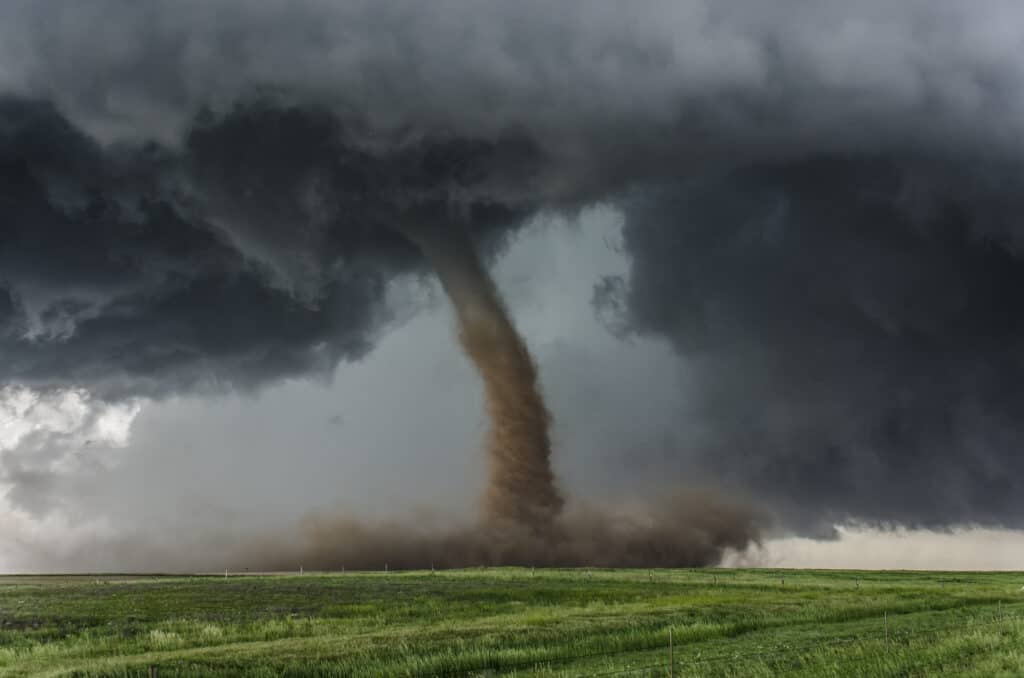Iowa is unique for being one of the most tornado-prone states in the country, with around 50 tornadoes hitting the state each year on average. It’s one of around 10 states that make up the notorious Tornado Alley, with its peak tornado season being spring and early summer. Below, we’ll take a look at Iowa’s most powerful and deadly tornado in recorded history and the unfortunate tornado outbreak associated with it. In addition, we’ll briefly address how tornadoes can affect Iowa’s wildlife.
Iowa’s Most Powerful and Deadly Tornado

©Tudoran Andrei/Shutterstock.com
While Iowa has had thousands of powerful and devastating tornadoes over the years, its most powerful and deadly in recorded history was the Charles City Tornado of 1968. Notably, it was part of the Tornado Outbreak of May 1968, which produced 46 tornadoes over just two days.
Out of all 46 storms that were part of this outbreak, only two registered as F5s on the Fujita Scale: one unnamed tornado that struck the northern Iowa counties of Fayette and Oelwein, and the Charles City Tornado, which had a 62-mile path and affected six counties in northern Iowa.
If you aren’t familiar with the Fujita Scale, the system ranks tornadoes based on their overall intensity. The main two factors it assesses are the storm’s speed and the damage caused. An F5 on this scale must reach speeds of at least 261 miles per hour and cause incredible, often irreparable damage to man-made structures and vegetation.
But Charles City didn’t just experience one tornado during this outbreak. Starting sometime during the late afternoon hours of May 15th, 1968, five tornadoes struck the northern Iowan town in the midst of the 1968 outbreak. Two were F1s, one was an F2, and two, as we touched on above, were F5s. Charles City’s Floyd County was directly in the path of the stronger F5 of the two. The other, less-damaging F5 also affected the area, albeit less directly.
In the aftermath of the Charles City Tornado, local officials estimated it caused over $30 million in damage. In addition, 13 people died, with 450 suffering serious injuries. 372 homes in the city were completely destroyed. 188 suffered major damages, and another 356 experienced minor damage. The outbreak also wiped out all eight of the town’s churches, along with three of its schools.
Learn More About the Tornado Outbreak of 1968

©Minerva Studio/Shutterstock.com
To be clear, the Tornado Outbreak of 1968 didn’t only strike Iowa, and the Charles City Tornado wasn’t the only devastating storm involved with the outbreak. In total, the 46 tornadoes associated with it actually struck 10 different states in the southern and midwestern United States, though Iowa and Arkansas were the most affected by this powerful cluster of tornadoes. Overall, the outbreak was Iowa’s deadliest in history, and it was one of North America’s deadliest since the 1960s.
Tragically, the outbreak hit the Midwest with little warning. This, in turn, gave the area’s residents very little time to evacuate. During the early afternoon hours of May 15th, 1968, severe weather activity began as a low-pressure system began to move southeast through Iowa, Missouri, Arkansas, and Illinois. The first cluster of tornadoes to touch down included the Charles City Tornado, along with the second unnamed F5 mentioned earlier.
But the outbreak wasn’t over after those first F5s hit. In fact, things were just beginning to unfold for Tornado Alley’s unlucky residents and the surrounding areas. As the system moved further southward, several deadly tornadoes struck northern Arkansas. Once again, local residents had little time to prepare or evacuate, as the area’s warning systems had failed initially. The outbreak killed 34 of Craighead County’s residents and one Jackson County resident. One of the tornadoes in this particular cluster, an F5, was Arkansas’ most deadly in over 15 years.
Eventually, the outbreak died down once it reached Tennessee and Mississippi. In total, the outbreak claimed 45 lives in Arkansas, 18 in Iowa, eight in Illinois, and one in Indiana. It’s estimated that structural damages exceeded $100 million across the 10 states affected. Charles City, Iowa, experienced around $30 million in losses alone.
How Do Tornadoes Affect Iowa’s Wildlife?

©iStock.com/Ronald Washington
Tornadoes can have a significant impact not just on us humans but also on entire species, food chains, and ecosystems. Iowa, in particular, is home to over 1,100 unique animal species. Most notably, this includes its official state animal, the American goldfinch. Smaller, more fragile animals like these can be especially vulnerable to tornadoes. The high wind speeds and associated damages can uproot trees, and completely wipe out the birds’ nests. This, in turn, can make it difficult for them to find food, shelter from predators, or mates.
In addition to destroying various animals’ habitats and limiting their access to food, the damage associated with tornadoes can create opportunities for invasive species to take over in their aftermath. Studies conducted by the University of Illinois have found that large, storm-prone forests can take years to fully recover after being hit by just one tornado.
As these affected forests attempt to regrow and recover, invasive plants are often resilient and hardy enough to take root in these harsh conditions. Furthermore, they can even spread further into surrounding, non-affected forested areas. This makes it even harder for native plant and animal species to return and re-establish themselves.
Fortunately, though, many recent studies also suggest the damaging ecological effects caused by tornadoes in Iowa are minimal long-term, at least to animals, even if they can be devastating to humans, vegetation, and man-made structures. Most species of birds, for example, are able to detect changes in air pressure just before storms arrive. This allows them to evacuate much more quickly than humans. But being forced to relocate so quickly is still dangerous for them, and more robust research is needed on the true long-term effects of tornadoes on Iowa’s wildlife.
The post Discover the Most Powerful Tornado to Ever Hit Iowa appeared first on AZ Animals.
from Animal News, Facts, Rankings, and More! - AZ Animals https://ift.tt/U7DhIpz